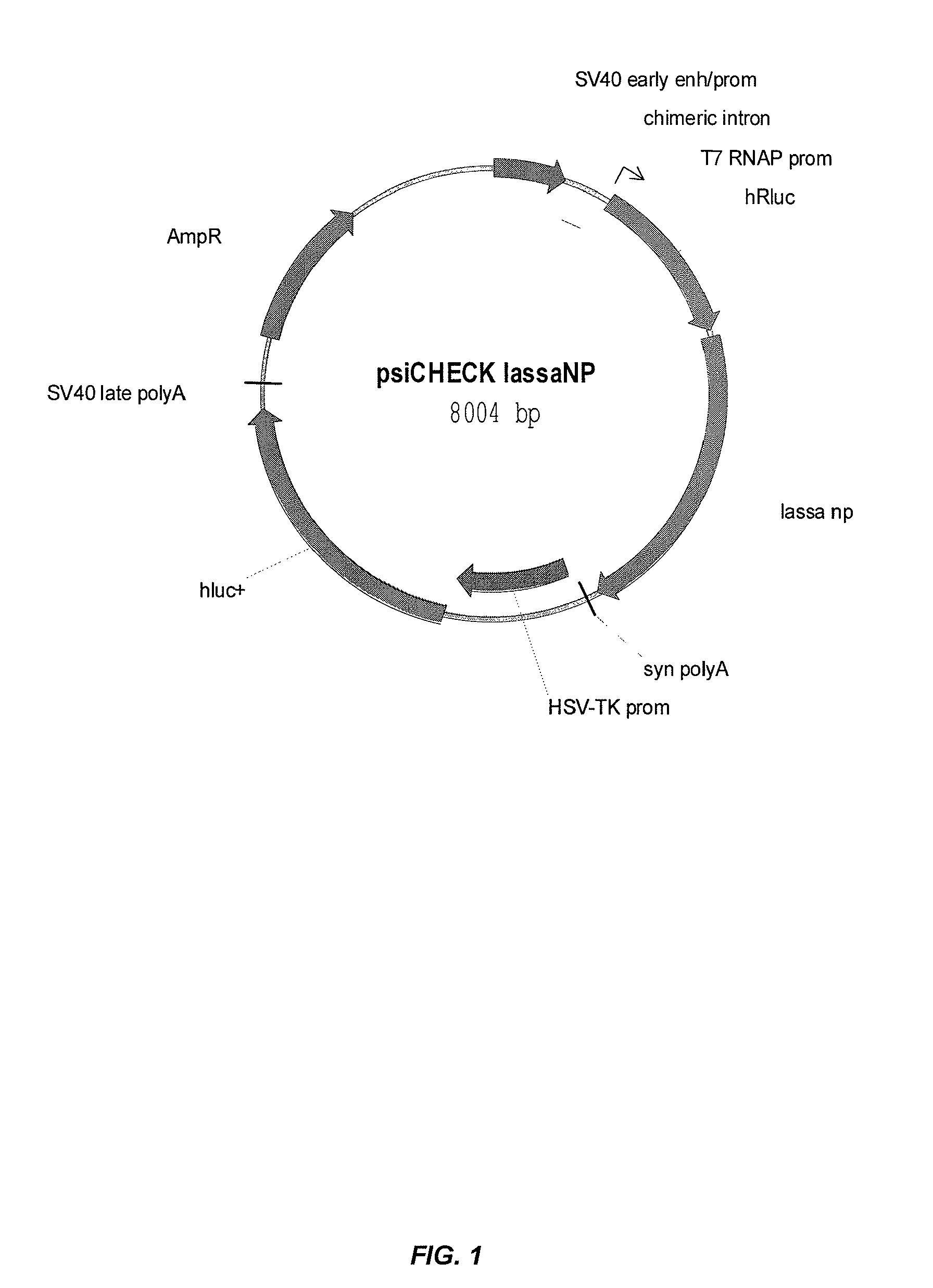Compositions and methods for silencing genes involved in hemorrhagic fever
- Summary
- Abstract
- Description
- Claims
- Application Information
AI Technical Summary
Benefits of technology
Problems solved by technology
Method used
Image
Examples
example 1
Stable Nucleic Acid Lipid Particle (SNALP)-Enabled siRNA-Based Therapy for Hemorrhagic Fever Viral Infection
I. Introduction
[0648]This example demonstrates the feasibility and anti-viral efficacy of broad-spectrum small-interfering RNA (siRNA)-based therapies targeting genes of Lassa Virus (LASV), a CDC Category A arenavirus. The candidate siRNAs and control sequences were designed and delivered using stable nucleic acid-lipid particles (SNALP). Properly designed siRNA can potently suppress the expression of target genes by harnessing the power of RNA interference (RNAi). Previous approaches to the treatment of arenaviruses have been limited and unsuccessful due to numerous technical and biological barriers. SNALP have been designed specifically to encapsulate and stabilize nucleic acids such as siRNA, and address the inability of current delivery systems to overcome the barriers to systemic delivery (e.g., effective delivery to the disease site and the target cell). The safety, effi...
example 2
In Vitro and In Vivo Activity Screen of Modified LASV and TF siRNAs
[0691]Human Tissue Factor (hTF or hF3) siRNAs of the same nucleotide sequence were modified to incorporate an increasing number and alternate patterns of 2′OMe nucleotides. 3 different sense strands (S-1 to S-3) and 7 different antisense strands (AS-1, AS-2, AS-3, AS-4, AS-5, AS-5b, and AS-6) were designed. hTF double-stranded siRNAs were generated by mix and match annealing of all possible combinations of sense strands and antisense strands. The number of modifications for double-stranded hTF siRNAs ranged from 3 to 10 2′OMe nucleotides in the double-stranded region. In some embodiments, the pattern of modification included 2′OMe-modified nucleotides in the 3′ overhang of one or both strands of the siRNA, such that the number of modifications was further increased in the entire siRNA molecule. Table 9 shows exemplary modified double-stranded hTF siRNAs that resulted from the mix and match annealing of sense strands ...
example 3
Potent Silencing of Tissue Factor (TF) Gene Expression with Modified TF siRNAs
[0697]This example demonstrates the relative activity of the hTF292 mod siRNA shown in Tables 8 and 9 (hTF292 S1 / AS1; also known as hF3 292 1 / 1) and the hTF369 mod siRNA shown in Table 8 (hTF369 S1 / AS1) targeting Tissue Factor (TF or F3) mRNA. The Human Umbilical Vein Endotheilal Cell (HUVEC) system, when activated by IL-1μ, is a sensitive system for examination of TF mRNA induction and resultant knockdown via RNAi in vitro. Example 1 illustrates that the hTF292 S1 / AS1 siRNA was more active than hTF369 S1 / AS1 siRNA in U937 and CD34 cell derived monocytes / macrophages. The HUVEC system was used in this study to further evaluate the knockdown of TF mRNA via the hTF292 S1 / AS1 and hTF369 S1 / AS1 siRNAs in a 1:57 SNALP formulation containing either DLin-C2K-DMA (“C2K”), MC4 Ether (“1-B17”), DLinDMA, or MC3 Ether (“1-B11”) as the cationic lipid component. The HUVEC system was also used in this study to evaluate an...
PUM
| Property | Measurement | Unit |
|---|---|---|
| Mass | aaaaa | aaaaa |
| Fraction | aaaaa | aaaaa |
| Fraction | aaaaa | aaaaa |
Abstract
Description
Claims
Application Information
 Login to View More
Login to View More - R&D
- Intellectual Property
- Life Sciences
- Materials
- Tech Scout
- Unparalleled Data Quality
- Higher Quality Content
- 60% Fewer Hallucinations
Browse by: Latest US Patents, China's latest patents, Technical Efficacy Thesaurus, Application Domain, Technology Topic, Popular Technical Reports.
© 2025 PatSnap. All rights reserved.Legal|Privacy policy|Modern Slavery Act Transparency Statement|Sitemap|About US| Contact US: help@patsnap.com



